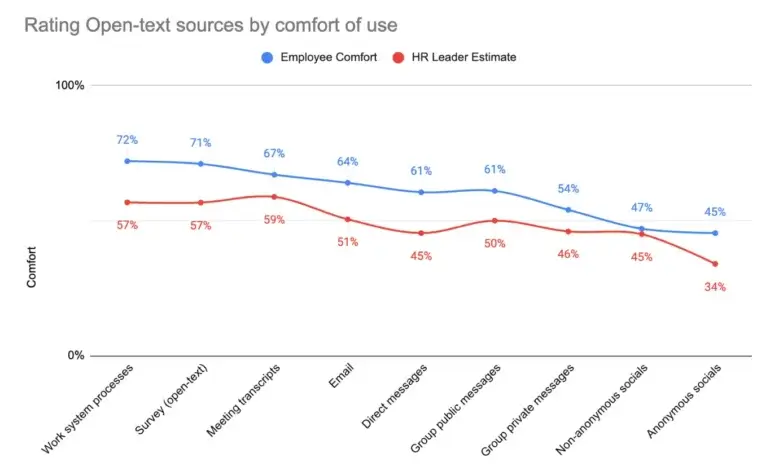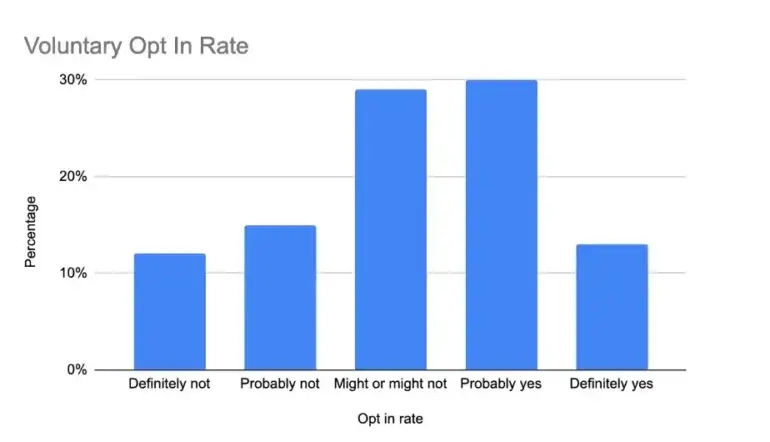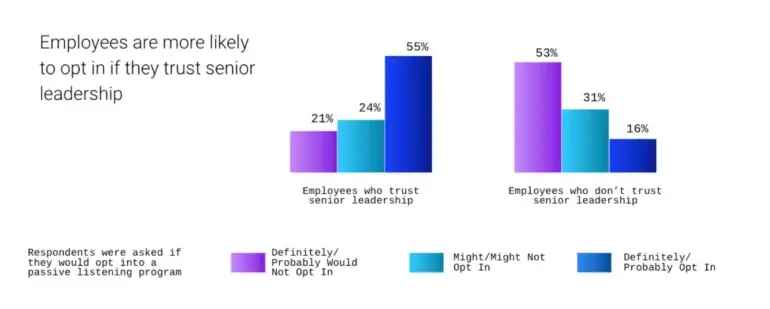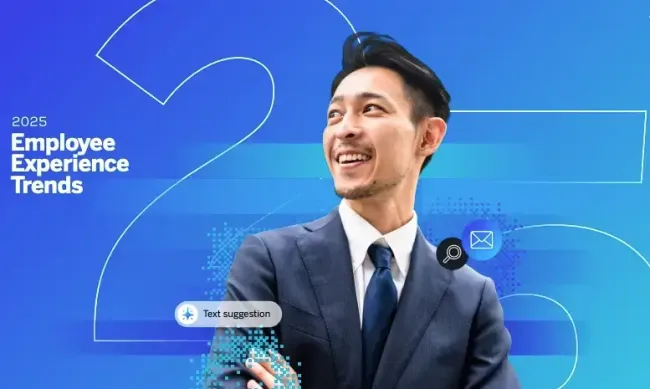According to Qualtrics research only 43% of employees feel like there is good follow-up on employee survey feedback. Employees want to be heard, but they don’t want to fill out a survey every day, just as managers and HR teams don’t want to build weekly action plans or set up monthly programs based on employee feedback. Everyone is looking for a way to effectively use employee insights as fuel for continuous improvement, without it being overwhelming.
Passive employee listening practices have become a proposed solution to improve the employee feedback loop. Passive listening practices use unsolicited and unstructured data employees already generate in their day-to-day activities – declining a meeting, answering a question in a public channel, emailing a customer - and analyze this data to create insights and understand an employee’s overall work experience. As artificial intelligence - the use of machine learning to rapidly pull, condense, and explain data - continues to improve, so does its accessibility.
By cutting down the effort required to effectively collect and process unstructured and unsolicited data, it is becoming increasingly easy and economical to use these insights to inform actions that improve employee experiences and organizational outcomes.
Compared to traditional, solicited survey-based feedback that is periodically collected, passive listening sources open up opportunities for continuous listening, timely feedback, and more diverse insights from employees. However, passive listening also comes with some challenges.
Privacy concerns are mounting, particularly around the risks of using passive listening for human-centered data processing and decision-making, and there is a lot of noise when handling this much data to cut through to get effective insights.
To uncover employee opinions on passive listening, this study focused on employee perceptions about the use of their qualitative text and behavioral data to inform decisions, HR leaders’ perceptions of employee sentiment towards this type of passive listening, and employee engagement compared to their opinions on passive listening. Employee buy-in is a crucial element in successful feedback loops, making it necessary to get a better view of how employees feel about AI and specifically passive listening.
Employee expectations of passive listening
According to our report, HR consistently underestimates employee comfort when it comes to using unsolicited and unstructured data sources. With AI advancing rapidly, it is reasonable for there to be caution when considering adopting this new technology. HR professionals also tend to be more risk averse than the average employee population - research done by Psychological Consultancy Ltd (PCL) found that almost 20% of HR professionals report being “prudent” in their assessment of risk. With the speed at which employee experience technology capabilities are developing, there is a lack of precedent for HR professionals to lean on when implementing new practices, as there is a risk of overstepping employee comfort levels.
For our research we focused on nine open-text data sources, open-text being any natural language communication data sources - seven work channels such as email and work systems, as well as external channels like anonymous and non-anonymous social media.

When it comes to using text data for Employee Experience Management the majority of employees are more comfortable than HR believes. Employees are substantially more comfortable with open text data collected from internal workplace sources - software used at work - being used to generate insights into their experiences than HR leaders anticipate. HR assumes desk workers were 10-15% less comfortable with the use of these data sources than they actually are. This includes everything from work systems processes such as IT tickets, to emails, and internal messages to coworkers.
- Employees are most comfortable with using text from internal work systems: Employees were most comfortable with the analysis of data from work processes (72%) and open text survey responses (71%).
- Employees are least comfortable with social media channels: Employees prefer the use of text data sourced from internal work channels rather than social media channels, including anonymous and non-anonymous socials. In fact, they were least comfortable with anonymous social media channels such as Reddit and Glassdoor, closely followed by non-anonymous channels like LinkedIn.
Privacy is the top concern
We asked employees to identify their top concerns with passive listening programs and asked HR leaders to estimate what employees’ biggest concerns would be.
- Privacy invasion was the most commonly cited concern with 57% of all employees citing this as a top concern. HR leaders correctly identified this as the top employee concern as well, and in other questions stated that it was also their top concern.
- Employees were more concerned with misinterpretation of data than HR leaders anticipated.
- HR leaders anticipated that fear of reprisal would be a greater concern than employees actually demonstrated.
Work level matters
Much like we found in our 2024 EX Trends research, work level matters when it comes to passive listening perception. We asked whether employees would proactively opt-in to a passive listening program if the data were used to identify and close experience gaps.
Demographic categories tested also included country, age, gender, tenure, and days spent in office. Only work level was shown to be a predictor of likeliness to opt into passive listening programs. The higher one’s work level within an organization, the more comfortable they are with these programs, and the more likely they are to opt-in.
Specifically, we asked employees whether or not they would voluntarily opt into a listening program that used their text data from sources like email and instant messages. This is how they responded:

And this was the breakdown by work level:
- Individual contributors are wary, but leaders are excited: excluding executives, 31% of employees said they might or might not opt in. For executives, 43% said they definitely would opt in.
- Most employees are at least open to the idea of opting into a passive listening program: Only 12% of employees say they definitely would not opt in. For individual contributors (who are more unsure), this number is 18%.
Organizational trust improves willingness to participate
There is a clear correlation between organizational trust and willingness to participate in data monitoring.

To measure trust, employees were asked the question “I trust the senior leaders in my organization to be transparent about the kinds of employee data they are collecting and how it is being used.” When compared to how employees responded about their willingness to opt-into a passive listening program, there was a direct relationship between opt-in and trust in leadership.
In our study, employees who are likely to recommend their company as a great place to work and/or trust the transparency of senior leadership are significantly more likely to opt-in to monitoring programs.
Employees who say they would probably or definitely not opt-into a passive listening program are 30% less likely to:
- Recommend their company as a good place to work.
- Believe that senior leadership will act on the insights they gain from employee feedback.
- Trust that senior leadership will be transparent about how they use employee feedback.
These responses show that having trust in an organization and its leadership will preemptively support a positive mindset about giving feedback and increase the chances employees will volunteer their data for passive listening programs. Ideally, organizational trust is already strong, but if trust is an issue and needs improvement for your organization, not all hope is lost.
We asked employees who weren’t sure, or responded negatively about opting in, if anything could change their mind and there were two conditions that respondents consistently shared:
- Transparency: Clear visibility about information use and handling was the majority for responses, with 55% saying that knowing the purpose of data collection and how the data would be used would increase their chances of opting in. 48% said visibility into what information is shared and who had access to the data would improve their comfort.
- Agency: Respondents also said they wanted to still have some control over their data. 44% said the ability to still opt-out later was important, and 43% said the ability to limit the types of communications that were analyzed would make them more willing to opt-in.
Ultimately, transparency and agency are important for employee comfort with passive listening practices in their workplaces, increasing the chance of them opting into the programs.
Recommendations for implementing passive listening programs
Overall, it’s clear that passive listening programs have viability and most employees would consider opting into these programs if they knew how the organization planned to use the data. Based on these findings, we encourage the following actions for organizations considering building a passive listening program:
- Build in transparency. Employees want to know what is happening with their data. Be explicit about how you will collect, analyze, store, share, and access this unstructured, unsolicited data. Having policies or ethical guidelines around data collection will help with structuring communications to foster transparency, and maintaining it over time. For examples on practicing transparency for passive listening, Qualtrics Ethical XM Guidelines - written specifically for AI use cases such as passive listening in XM.
- Ensure privacy. On top of developing safe and secure technology that ensures ethical use of data, organizations should define their own privacy policies and communicate these policies to employees, which will help build employee trust in the security of their data. This includes considering the security and storage of data collected (e.g., making sure it is encrypted and only visible to authorized personnel), having purpose and use limitations for data (e.g., not using it for individual evaluations or disciplinary action), and having set boundaries on data retention (e.g., knowing the expiry date on data storage securely delete it).
- Tailor communications. Develop targeted communication strategies that address specific concerns and expected benefits relevant to different employee groups. Highlight the various benefits that come with a passive listening program, and address privacy concerns and guarantee data security. For individual contributors, focus more on tangible daily improvements like workplace safety and technology improvements, while frontline or mid-level managers might care more about highlighting employee generated innovations or opinions on work processes. Ensure employees understand the boundaries of these programs, their ability to opt in or out, and encourage all stakeholders to share feedback about the insights and experience of using passive listening.
- Test your own assumptions. HR leaders are understandably risk averse as they often manage employee experiences and expectations for large and diverse organizations. The downside is that risk aversion can also mean avoiding the unknown, taking less creative routes to get to their end goal, or waiting for other organizations to write the playbook before acting. This research is the start of that playbook. Employees have concerns, but they are not as uncomfortable with passive listening and the use of AI as many HR leaders would think. Given how quickly this space is evolving, continue to test your assumptions and explore new options for understanding and improving employee experiences.
- Foster organizational trust. Enhance efforts to improve organizational trust, as it directly impacts the willingness of employees to participate in monitoring programs. By acting on the other recommendations, and using the Qualtrics Ethical XM guidelines to ensure the transparency, competence, effectiveness, governance, and accountability of your XM programs, trust should follow. Trust is something that needs to be nurtured, and acting consistently with employee interests in mind – and communicating transparently, about the good, the bad, and everything in between – will foster organizational trust.
Take a deeper dive into the data on why passive employee listening is on the rise



